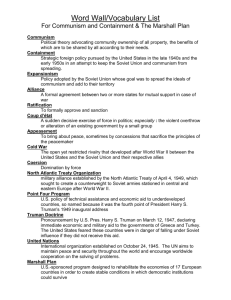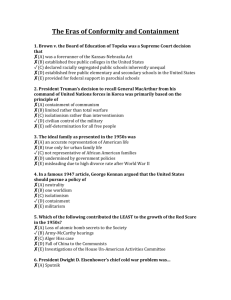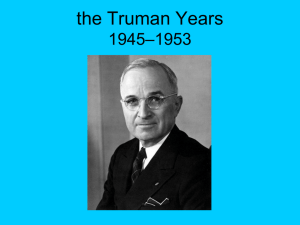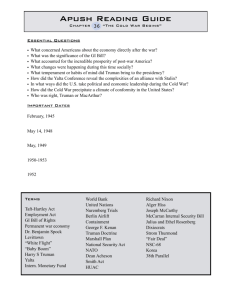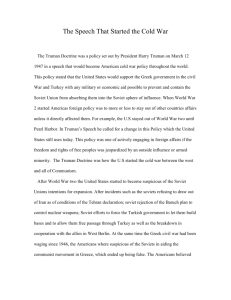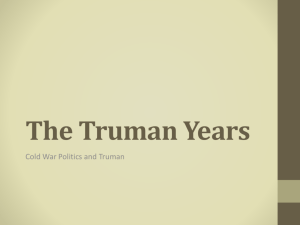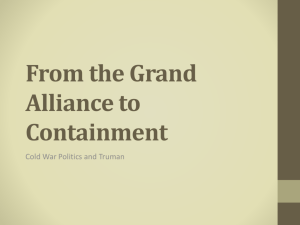Post WW II US Foreign Policy
advertisement
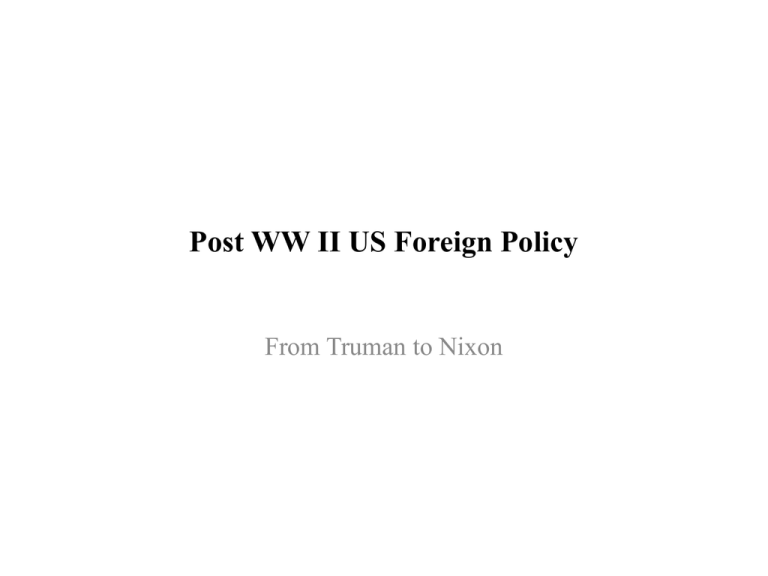
Post WW II US Foreign Policy From Truman to Nixon Truman Administration Foreign Policy 1946-1953 Three Main Areas of Policy 1. Economic -- Economic growth - free trade access to global markets and materials (Capitalism) 2. Political -- Order, Stability, Freedom to determine political regimes, collective security, anti-communism, promoting Democracy 3. Security -- Order, Stability "Containment" Truman administration policies were “constructed” to “solve” a set of concrete problems Problems – Governmental Selection Greece-Turkey – aggression/subversion Solutions None Truman Doctrine – containment military aid West European Marshall Plan Economic and Political Economic Aid Instability –1948 War scare NATO – Formal Containment Military 1. Greece/Turkey and the Truman Doctrine http://www.youtube.com/watch?v=wmQD_W8Pcxghttp://www.youtube.com/ watch?v=wmQD_W8Pcxg -- to full 18 minute speech Administration chooses to make a big deal out of the Civil War in Greece Containment and the role of World Policeman is born Truman "I believe that it must be the policy of the United States to support free peoples who are resisting attempted subjugation by armed minorities or by outside pressure" 3/12/47 Emergency military and Economic Assistance – money, arms, military trainers and economic advisers requested $400 millions in aid to Greece and Turkey • • • • • • • 2. Marshall Plan A pragmatic approach to addressing the problems of Western Europe supply capital, tools, food to restore Europe economic non-militaristic, non-ideological - humanitarian, common sense August 1947 - European Recovery Plan -- $28 billion -- December 1947 to Congress 17 billion -something for everyone -Humanitarian Economic - Foreign markets, avoid depression, very good for U.S. businesses Pol/mil - stems pol and economic chaos and instability in W. Europe Marshall Plan and incredible success -- poured 13 billion into Europe about 90 billion in current dollars -- template for future - creating economic/pol stability and growth - applied with less success other places 3. NATO last phase - the security part Why did policymakers see military commitments to Europe as necessary answers in part found in the famous scholarly article by "X" (George Kennan) -- led to belief in the necessity of military commitments "the adroit and vigilant application of counterforce at a series of constantly shifting geographical and political points corresponding to the shifts and maneuvers of Soviet Policy" essential misinterpretation -- from pol/economic - military key to NATO - formalization of western alliance - entangling alliance commitment to Europe - a formal presence and role in Europe institutional commitment High level U.S. foreign policy maker - (Lovett) -- departure from the past "The U.S. had sought peace through weakness now it seeks peace through strength." High Times for the Truman Adminstration. A string of major foreign policy successes A major come from behind victory 1948 Presidential Election Success in May of 1949 in overcoming the Soviet effort to isolate and break Berlin - blockade given up Communist revolution in Greece had failed - M. Plan working, Berlin was relieved, West allied against the Soviet threat -- "America, Winston Churchill proclaimed "has saved the world" BUT Three big problems on the horizon 1 Republicans bitter at election loss -- pursue a destructive but effective strategy against Truman and the democrats 2 "Loss" of China 3 Soviet detonation of an atomic bomb The Plan to Run the World and Win the Cold War -- NSC-68 NSC – 68 (Beginning of 1950) Why? Policy of Global Leadership in place but little capability to do the Job Realization of Problems Europe - Conventional Soviet Threat S. Korea - Lacking capability to protect clients states Loss of Nuclear Monopoly Growing political and military problems in the developing world --Vietnam Structure of NSC- 68 • • • • • • The enemy - The Soviet Threat and Rhetoric Basic Strategy U.S. Intentions - Containment Containment via Aggregate superior military strength The Present Risks Possible Courses of Action 1. continue current policies 2. isolation 3. war 4. a more rapid buildup of the pol, eco, and mil strength of the free world than provided under 1 above • • • • • Why no general War -- no first use of nuclear weapons Key Policy Features of NSC- 68 How to Win the Cold War 1. Negotiate with Soviets from position of strength 2. No Direct War 3. Build Economically and outlast the Soviet Union 4. Contain by combination of aggregate superior military strength and the construction of a strong periphery (foreign military and economic aid - advisers - military presence oversees) 5. develop intelligence and covert operations NSC structure continued • capabilities (develop the CIA) 6. Develop strong unified democratic West 7. Build up military strength 8. develop domestic internal security and civil defense programs 9. reduce the Federal deficit and defer domestic programs 10. Increase taxes • Raising overall security spending by three fold from approx 14 Billion to 35 billion • How to sell this politically? -- Cut desirable domestic programs, raise taxes to increase security -Policy makers have no answer Truman and The Korean War 1950-1953 • • • • • 1. How to Sell NSC-68 2. N. Korea Invades June 26, 1950 Problem -- Solution and the Co-evolution of Policy A. Defining the Problem --- "Soviet inspired and supported" B. World War III? C. Implementing Containment - Helping a Client State facing external aggression D. Quickly up the military escalatory ladder till U.S. combat troops deployed with combat mission for an indefinite period of time 3. Policy Chaos - Summer till Fall - Containment or rollback (liberation) --- Rollback it is and across the 38th parallel 4. Winter 1950-1951 - Limited War or all out War - the Struggle between Truman and MacArthur 5. Why no "peace" until 1953 The Korean War Legacy • Permanent Cold War - Hostility toward the Soviet Union and Communist China • permanent tension and risk • Clashes on the periphery • Political Destruction of the Truman Presidency and the "lesson of Korea" • U.S. rearmament 1949 11.1 Billion 1952 57.7 Billion 1953 35.0 Billion • U.S. Troops deployed to Europe • Containment practiced in Asia • Expanded military establishment and permanent arms industry - the mil/ind complex • Problems - unpopular limited wars, and the psychology of containment

